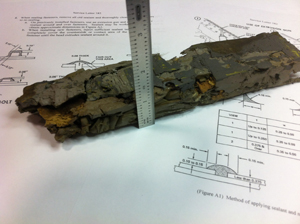Sealing the Deal


Chunk of dried sealant was removed from around picture window channel/aft pressure bulkhead.
Used correctly, flexible sealant is an essential tool for aircraft technicians looking to plug leaks in the pressure vessel that are too small or remote to treat with conventional fasteners. Used incorrectly, sealant can mask the very problem it is intended to correct.
The accompanying photos show the result of incorrect use of sealant. These chunks of sealant were discovered during an inspection of the upper picture window channel in a 690-series Twin Commander. Similar massive chunks of hardened sealant--all of it adding up to a couple of pounds--were found when inspecting the aft pressure bulkhead area, and the wing spar-fuselage frame attach area.
Given the complexity of the airframe structure in that area of the aircraft and the normal flexing that occurs with flight loads and landing forces, it stands to reason that it is susceptible to small pressurization leaks. These leaks, in combination with small leaks in other areas of the pressure vessel, can add up to significant degradation of the pressure differential, resulting in a higher-than-normal cabin altitude in cruise.
The usual prescription for loss of pressurization is to apply sealant in the affected areas to block the leaks, restore pressure differential, and lower cabin altitude. However, too much of a good thing is rarely good, and as these photos demonstrate, that is the case when using too much sealant.
Sealant is used by every aircraft manufacturer during the production process. It was used on every pressurized Commander built. Given the current age of the typical Twin Commander, it's a given that, over the years, more sealant has been applied in the pressure vessel.
The easy way to treat a suspected pressurization leak is to apply fresh sealant over old, but that doesn't always work. The old sealant may have separated from the surface it was intended to seal, so the new sealant is not able to do its job. The correct procedure is to remove the old sealant, clean the area, and apply new sealant.
Partly in response to problems seen in the field concerning the treating of pressurization leaks, Twin Commander Aircraft in 2008 released two service letters--SL 382 and SL 383--in an effort to standardize the procedure for sealing the known and most significant leakage areas in the pressure vessel. (SL 382 applies to all Twin Commanders pressurized to the floor. SL 383 applies to the 690D and 695A and B, which are pressurized to the skin and have a higher cabin pressure differential.)
Among other instructions to technicians contained in each service letter is an admonition to "...not apply new sealant over old sealant."
The service letters also detail procedures for checking for pressurization leaks and determining the extent of those leaks, and for sealing each area in the cabin where the most significant pressurization leakage can occur. In the 690D and 695A and B, those areas are the main cabin door seal, cabin entrance step, emergency exit seals, wing-root bulkhead, forward and aft pressure bulkheads, outflow valves, and skin lap joints.
In all other pressurized Twin Commanders, the areas susceptible to leaks are the boots at the bases of the rudder pedals and control column, the main cabin door seal, emergency exit seals, wing root bulkhead, forward and aft pressure bulkheads, outflow valves, floor ducts, floor panels, and skin lap joints.

Graphic shows primary areas where cabin pressure leakage can occur in 690C.
The two service letters are referenced in Service Bulletin 241, which is expected to be released this September (see SB 241 story this issue). After accomplishing the modifications spelled out in SB 241, applying the proper sealant the proper way should eliminate the need to repeatedly go back in the wing root, picture window, and aft pressure bulkhead areas to shore up those nagging pressurization leaks.
Discuss this article in the forums...







